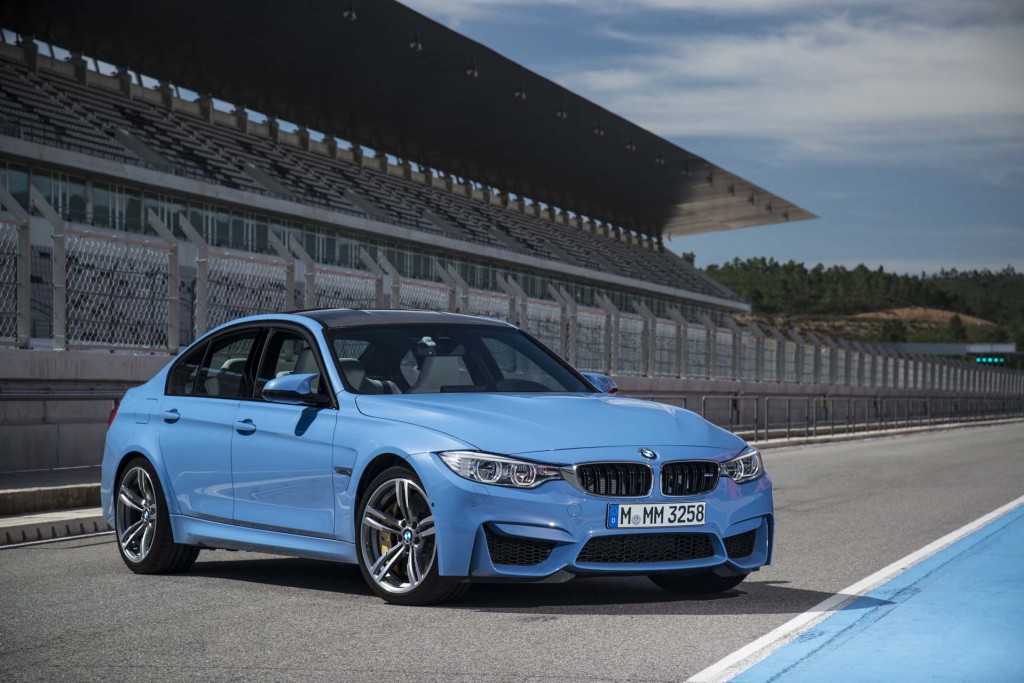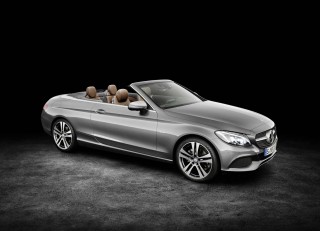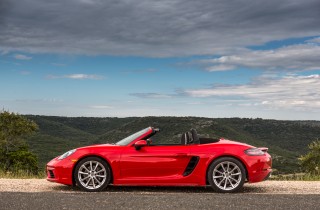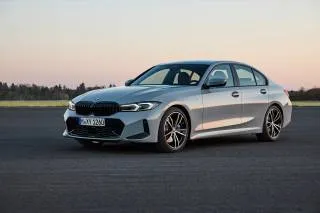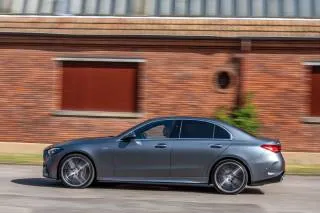Likes
- Superlative performance
- Four (relatively) useful seats
- Available carbon ceramic brakes are great...
Dislikes
- ...but very expensive
- Bad packaging for a simple rearview camera
- Everything costs more, unless you like white and black cloth
- Not fuel efficient
Buying tip
features & specs
The 2017 BMW M3 is a track-ready sports sedan with an unblemished pedigree that announces to the world: "Ask me what DTM means."
BMW's obsession to fill every niche isn't new. Before the BMW 3-Series, a "luxury sport compact" could have applied to a versatile woman's handbag or described Ricardo Montalban's suit.
The 3-Series changed that more than three decades ago.
For 2017, the BMW 3-Series comes in three body styles, with a choice between six different engines, two powertrains, and two transmission choices. Want details? The 3-Series comes in 320i, 320i xDrive, 328d, 328d xDrive, 330i, 330i xDrive, 340i, 340i xDrive sedan flavors; a 330e iPerformance plug-in hybrid sedan; 330i xDrive Gran Turismo and 340i xDrive Gran Turismo tall hatchbacks; 330i and 328d xDrive wagon; and the almighty M3 (which we cover separately). Inhale, exhale.
The 2017 BMW 3-Series earns a 6.8 overall on our scale, which reflects its good fuel economy, safety, and performance. (Read more about how we rate cars.)
Style and performance
The BMW 3-Series is dressed for dinner with the parents. The sharp exterior was updated for 2016 and carries on this year, still sharp. The grille and headlights were made bigger slightly and the back end is more distinctive than before.
It's a elegant and classic look from the 3-Series, and one that won't get old soon.
We can't say the same about the 3-Series everywhere else. The interior is starting to look a little plain and outdated, compared to the techno-blitzes from Audi and Mercedes-Benz in their A4 and C-Class, respectively. Interior materials range from rich and luxurious to muddled and fussy—even a little cheap. Spend more and get more, it's a recurring theme.
Under hood is a variety of powerplants that range from efficient (328d diesel and 330e hybrid) to blistering fast (M3 and 340i) or more commonly commuter (320i and 330i).
New for 2017, the 330i probably hits the goldilocks spot for most drivers. Its uprated 248 horsepower and improved feel from last year's model should make it a more competent performer for most buyers. We've driven the new turbo-4 in the 5-Series (which is a heavier car by 300 lbs) and it feels aptly powered there—it's hard to imagine it'd feel worse in a lighter car.
The 340i's turbo-6 and 320 hp will brighten anyone's day and tempt every right foot. Mash the throttle and the 340i spins up an overwhelming and instant 330 pound-feet of twist that used to only come with M3 badges.
Lessees may consider the 320i's tempting entry price, but we say skip the Starbucks each month and skip the 180-hp 320i—the 330i's turbo-4 will be worth it.
In 320i, 330i, and 340i models, a 6-speed manual transmission is available at every stop (the 330i doesn't offer a manual with all-wheel drive) and we applaud BMW's efforts for bringing those models to the U.S. We cheer even louder for the 8-speed automatic that seems telepathic and instant in its shifiting, and sport programs that make us almost forget how much we love a manual. (We said almost.)
In any case, every 3-Series is a sharp handler with an excellent feel and flat attitudes. The electric-assisted steering is weighted nicely and manages to push back when the 3-Series is running out of grip and we're running out of talent.
Comfort, safety, and features
Although this is the biggest 3-Series yet, it's still very much a compact car. Front seat riders get good seats with adequate bolstering and nice leg support. The rear seats are good for children or small adults on long trips; tall riders may want to consider horsetrading with front riders to get enough room to be comfortable.
Unlike trendier shapes that cut into rear head room, the 3-Series offers good space for tall torsos in back, and it's traditional design makes for better cargo room too. The trunk's 15.8 cubic feet of space is enough to swallow plenty of gear.
The 3-Series improved its rating by the IIHS this year to be a Top Safety Pick+ (when equipped with a lighting package and $4,000 in options) and has a five-star overall rating from federal testers.
Outward visibility is surprisingly good in the 3-Series, but BMW frustratingly saddles a rearview camera with a $400 price tag.
Base 320i sedans are fairly spartan, considering their mid-$30,000 price tag. Standard equipment includes 17-inch wheels, manually adjustable front seats, leatherette upholstery, Bluetooth connectivity, automatic headlights, dual-zone climate control, and a 6.5-inch display for its infotainment system, which BMW calls iDrive.
Bigger wheels, better infotainment, and more creature comforts all come with a higher price tag, some of which seem excessive. Heated seats help in northern states, and we'd always suggest better performance. A $745 carbon fiber rear spoiler? Maybe not.
Before you scoff at $300 for Apple CarPlay, which other automakers seemingly throw in for free, consider that BMW's system runs without wires. That may help justify that big bill for BMW's new feature for 2017. (We said may.)
2017 BMW 3-Series Styling
BMW's 3-Series is classic and elegant from the outside, from the inside is another story.
The 2017 BMW 3-Series is now the oldest among German competitors in terms of design. From the exterior, you'd be hard-pressed to notice, but from the interior that fact is hard to miss.
The exterior shape is clean, simple, and still elegant. We'd call it very good. The interior lines don't hold up, and technophiles will be disappointed. We give it a 6 out of 10 on style. (Read more about how we rate cars.)
BMW updated the 3-Series last year with an new look that cuts a sharper hold in the air. The 2017 BMW 3-Series has more distinct headlights and taillights, bigger air intakes, reshaped bumpers, and its rising belt line helps lower the hoodline. We like the look compared to other wedge-shaped sedans, and the BMW manages to be expressive without being flashy.
There's also the 2017 3-Series Gran Turismo, a five-door hatchback with significant dimensional differences: nearly 8 inches longer overall, about 4 inches longer in wheelbase, and about 3 inches taller. Frameless windows, a large hatchback, and a rear spoiler, along with the coupe-like profile, push this model in a new direction that appears as one third fastback, one third wagon, and one third crossover. While its shape and sheet metal are unique, it's still instantly recognizable as part of the 3-Series family.
Inside, the flat dashboard opts for a more horizontal approach that's only broken by the freestanding infotainment screen. Although the screen doesn't look like an afterthought in the overall design, it's the most modern part of the dashboard and the control console and is in need of a refresh with newer materials.
The 3-Series can be equipped with many different trim lines and appearance packages, but try before you buy because they tend to make a greater difference inside and some combinations can be visually startling. The Sport Line, optional last year, is standard on the 328i, 328d, and 340i. There's also an M Sport package and—new this year—a Track Handling package notable for brakes with distinctive blue calipers.
2017 BMW 3-Series Performance
The 3-Series still remains a standout in the segment for performance in certain configurations.
Time and competition has finally caught up to the BMW 3-Series, but that doesn't mean the sport compact isn't out of ideas. And we're not talking about the M3 either.
The lineup is long and exhaustive, but we've distilled our performance into the following rating. The 8-speed is very good. The new turbo-4 is probably even better. The 3-Series earns a 7 out of 10 on our scale for performance. (Read more about how we rate cars.)
First, a disclosure: We haven't yet driven new versions of the 330i with BMW's upgraded turbo-4. We have driven that engine in the 530i and can report that it's potent enough to motivate the bigger 5-Series up to 60 mph in 6 seconds, and BMW estimates it'll make the same run in the 3-Series right at 5.5 seconds. It sounds better than the outgoing turbo-4, makes 248 horsepower (8 more than the turbo-4 in the 2016 328i), and is plenty sharp.
Our powers of deduction lead us to believe that in a lighter-weight application (the 3-Series weighs more than 300 pounds less than the new 5-Series) the new turbo-4 should be just as as impressive. We'll update this space if that changes at all.
While we applaud BMW for making a manual transmission available at nearly every stop, it's the 8-speed auto that we'd heap more praise upon. The quick-shifting autobox doesn't seem lost for gears and, on the race track, might be the quickest way around the circuit. We like the 8-speed's logic and precision, and wouldn't fault many buyers for opting for two pedals, rather than three. (Heaven help us.)
But the BMW 3-Series doesn't disappoint if you deviate from our suggestions—mostly. In sportier 340i configuration, with a healthy 320 hp on tap from the turbo-6, the 3-Series supremely quick and a talented performer on the street. We like the instant 330 pound-feet of torque that the 340i provides, and the purists among us will appreciate the 3.0-liter inline configuration too.
Rare turbodiesel models draw down the horsepower to 180 hp (but not the torque) for better mileage and smoother driving habits. It's available only with the automatic and went into production in January, likely a short run. If a diesel wagon is your bag you'll find it here in the 3-Series, but hurry. The 328d won't last long—and make it brown, while you're at it.
As for the entry 320i model, which makes 180 hp from a turbo-4 and can run up to 60 mph in 7.1 seconds, it's an option. Price-fixed buyers will certainly gravitate toward its low monthly lease rate and identical shape, but we say skip the Starbucks each month and put it toward a better engine. You'll thank us later.
The 330e iPerformance pairs a 7.6-kwh hour lithium-ion battery to a turbo-4 to make a combined 248 hp. Outside of very limited driving in Wisconsin, we haven't had much time to sample this model. Stay tuned and we'll update this space as soon as we can.
Regardless of engine configuration, the BMW 3-Series has a relatively smooth ride. Most BMWs, including the 3-Series models run on rock-hard run-flat tires that aren't doing ride quality any favors, and BMW's standard setup has been to make the suspension overly soft to compensate. Most daily drives won't be grating, but if you're looking for flaws, we'd point first to the standard tires.
All 3-Series cars now get an electric power steering system that loads and unloads nicely, and gives you—when you finally reach the 3’s impressive limits of grip—a little feedback from the road. We'd only wish for a better sense of the roadway surface before you approach those limits, which is what the hydraulic steering provided. A premium variable sport steering option permits easier parking along with sharper handling by altering the ratio mechanically, avoiding the digital transitions that can make electric power steering systems frustrating.
Driving Dynamics Control is included for the entire 3-Series lineup. With a rocker switch that’s right beside the driver’s knee, you can toggle between Eco Pro, Comfort (default), Sport, and Sport+ modes. With Sport, you get sharpened steering response, delayed shift points, and such, while Sport+ allows more slip from the stability control.
BMW offers a variety of sport-tuned options that can add seriousness, if not outright punch, to the lesser cars. There's an available M Sport package that drops ride height for sedans by 0.4 inches, firms up springs and dampers, and includes larger anti-roll bars along with larger 18- or 19-inch M alloy wheels. A new Track Handling package for gasoline-powered models includes variable sport steering, the Adaptive M Sport suspension and brakes with distinctive blue calipers. While these packages do offer improvements you can feel, they aren't necessary if you're looking for good ride quality combined with satisfying, crisp control for all but serious track use.
2017 BMW 3-Series Comfort & Quality
For front-seat riders in the 2017 BMW 3-Series: stretch out. For back-seat riders: stretch.
The 2017 BMW 3-Series might be the biggest yet to wear the badges, but that doesn't mean it's big.
Front-seat riders get premium positions, back-seat passengers should be limber—especially during long hauls.
Based on a cramped back seat, a 6 out of 10 is the best we can do on our comfort scale. We give the 3-Series points for good, supportive front thrones, but that's it. (Read more about how we rate cars.)
In all models, we like the adjustability and natural seating position that the 3-Series affords in the front. From base chairs on up to the 340i's sport buckets, each seat has a nice long bottom seat cushion and comfortable thigh support. Sport seats on the 340i (which can be swapped out for luxury seats for no charge, new for 2017) have even more thigh support and stronger side bolsters, but every stop is adequate.
In back, rear-seat riders are only afforded 35.1 inches of leg room—nearly identical space to the Mercedes-Benz C300, and they didn't get the point either. Once you're in, at least the BMW 3-Series offers more head room than the related C-Class, which we appreciate. We'd stop short of saying "No one under 6-feet tall is allowed to ride" mostly because all-torso types may fit just fine, lanky 6-footers will wish for more deeply scalloped front seats.
In the trunk, we'd prefer a wider opening and split-folding rear seats aren't standard on base models. Still, the 15.8 cubic feet of cargo room dwarfs the Mercedes' 12.6 cubic feet and most of the space is usable too.
Ergonomically speaking, the BMW 3-Series is breeze to master, although the steering wheel controls and head-up display can be tricky to learn at first.
Same goes for iDrive, which is the name BMW gives to its infotainment system. On 3-Series models equipped with navigation, BMW's latest iDrive 5.0 system is standard, which combines multiple inputs for the same command. Drivers can speak, twist, bump, trace, or touch inputs into the system, depending on their preference. Changing the radio station can turn into an impromptu game of "BopIt!" if you're not familiar. Our advice, take a dealer tutorial—pick a method for doing things and stick with it.
2017 BMW 3-Series Safety
The 2017 BMW 3-Series nearly aced crash tests, but advanced safety features come with a hefty price tag.
The 2017 BMW 3-Series has an impressive scorecard of official safety ratings that should give comfort to any safety-conscious buyer.
The 3-Series has been rated a Top Safety Pick+ by the IIHS in certain configurations, and federal testers have given it top five-star overall mark and places it firmly at the top of the list among competitors in crash safety.
Thanks to those superlative scores it earns an 7 out of 10 on our safety scale. We would go higher, but BMW insists on charging more for safety features that others can do for less. (Read more about how we rate cars.)
Let's talk about the good news first. BMW's 3-Series improved dramatically this year on the IIHS' notoriously tricky small overlap crash test thanks to a redesigned front wheel structure that was actually improved for 2016, but strengthened further this year to better control wheel movement in a simulated crash against a tree or light pole. The resulting changes improved last year's "Marginal" score to a "Good" score this year.
Also, BMW's improved optional headlights in its Lighting package earned an "Acceptable" rating from the agency, especially around curves. It's worth noting that the standard LED headlights still rate as "Poor" by the agency.
Federal testers gave the 3-Series a five-star overall rating, with five stars for rollover and side impact protection, but only a four-star rating for front crash protection.
Now, the not-so-good news. BMW's optional forward collision warning with automatic emergency braking system is buried in up to $4,000 of pricey add-ons. Similarly, a basic rearview camera is a $400 standalone option, or part of a $950 package that includes parking sensors and is required for emergency braking systems. The Top Safety Pick+ status applies to those cars equipped with all of the above, making the qualification a pricey one for buyers.
Those packages also add a surround-view camera, blind spot monitor, lane departure warning, and speed limit data included in the navigation system.
2017 BMW 3-Series Features
Spartan base models are hard to find and aren't ideal; if you're in the market for a new 3-Series we suggest a supplemental budget for better goodies.
Base models of the 2017 BMW 3-Series aren't opulently equipped by luxury-sedan standards, even less so if you consider the sedan's $34,445 starting price.
The 2017 BMW 320i's list of standard equipment includes 17-inch wheels, manually adjustable front seats, leatherette upholstery, Bluetooth connectivity, automatic headlights, dual-zone climate control, and a 6.5-inch display for its infotainment system, which BMW calls iDrive.
Our rating of 7 out of 10 reflects the good size for the iDrive screen, good options packages for well-heeled buyers and plenty of customizability. We withheld a point for base content compared to rivals, however. (Read more about how we rate cars.)
Many BMW 3-Series won't leave the factory bone stock, however. Among the more popular options are a Premium package that adds leather upholstery, power adjustable front seats, a moonroof, and keyless ignition for $3,100. A cold weather package adds heated front and rear seats for $800, and an upgraded lighting package adds LED headlights, which helped the car qualify for a Top Safety Pick+ rating by the IIHS. (We discuss that separately.)
Sport packages can add M Sport touches inside and 18-inch wheels on the outside, while track packages double down with better brakes and adaptive suspension.
Opting for navigation brings with it an 8.8-inch screen and multiple inputs for the iDrive system, including a rotary knob, touchpad, voice recognition, and a touchscreen that finally makes the system more user-friendly.
If you're willing to shell out nearly $50,000 for the bigger engine found in 340i models, you're treated to better base equipment too. Those models are equipped with LED headlights, power adjustable front seats, a premium sound system, keyless entry and wood trim.
Frustratingly, BMW charges buyers at every stop for popular options found on other cars as no-cost options: Apple CarPlay compatibility is $300, and a rearview camera is $400 as a standalone option.
(We'd like to offer the following footnote on the extra cost on CarPlay: For 2017, BMW's system doesn't require a hard wire into the phone for CarPlay to work. We've sampled wireless CarPlay on the 5-Series and can report that it's fantastic. Whether it's worth the added cost: Um, maybe?)
BMW's iDrive system has its fair share of critics, but the system has been refined over the last few years to bring it closer to others in the class. If you're new to the brand, the learning curve for the controller can be fairly steep, but the screen is sharp, crisp, and responsive.
2017 BMW 3-Series Fuel Economy
With plenty of models to choose from, the 2017 BMW 3-Series manages to stay relatively fuel efficient at every stop.
With a larger shift toward smaller, turbocharged engines, the 2017 BMW 3-Series is relatively fuel efficient throughout most of its lineup.
The most popular version of the 3-Series, the 2017 BMW 330i, manages 23 mpg city, 34 highway, 27 combined. Adding all-wheel drive, which BMW calls xDrive, knocks the combined and highway numbers down 1 mpg.
That's good enough for a 7 out of 10 on our fuel economy scale, and most models don't deviate far from those numbers either. (Read more about how we rate cars.)
With five engine choices, two powertrain configurations, and three body styles to choose from, nailing down exact numbers may be hard to do (and that's without considering the high-po M3, which we cover separately) but they're all competitive with others in its class.
Opting for the less powerful 320i doesn't net a huge increase in fuel savings. Those models, which are powered by the same 2.0-liter turbo-4 found in the 330i, manage nearly the same mileage at 23/35/28 mpg.
Stepping up to the turbo-6 in the 340i dims mileage slightly: 21/32/25 mpg. Adding xDrive to these models, or any model in the 3-Series range, usually shaves 1 mpg off the highway and combined ratings.
The most fuel-efficient version for 2017 is the turbodiesel 328d, which recently went back into production. These hard-to-find models are rated by the EPA at 31/43/36 mpg for sedans, and 30/40/34 mpg for wagons.
The plug-in hybrid 330e is rated at 34 mpg combined, with an all-electric range of 14 miles. Those models carry a high $4,000 premium for the battery packs, so prospective shoppers should consider how long they plan on keeping those cars to realize any return on that investment.
The entire 3-Series lineup enhances fuel efficiency with a start-stop system that shuts the engine off at stop lights; this happens only when automatics are in drive or manuals are in gear with clutch and brake pedals depressed. A Brake Energy Regeneration system, used in some models, further reduces fuel usage by delaying aggressive alternator usage until you brake. You'll also save gas with an Eco Pro mode that softens throttle response, shifts earlier, and makes accessory operation more efficient.
The comparable Mercedes model isn't far off. The 2017 Mercedes-Benz C300 sedan is rated by the EPA at 24/34/28 mpg.
